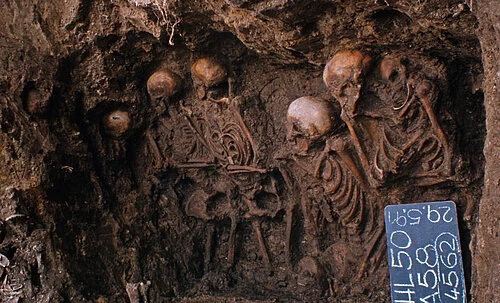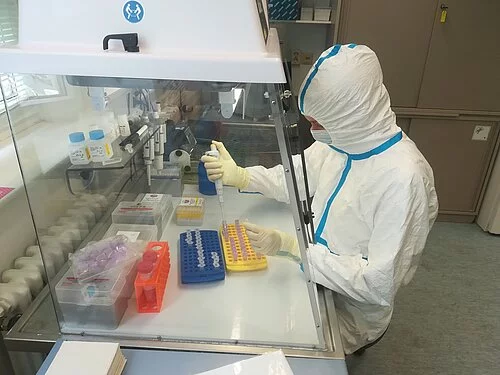Risk gene increased susceptibility to paratyphoid fever in medieval Europe
Gene variant associated with medieval paratyphoid fever outbreaks today increases the risk of inflammatory diseases.
Paratyphoid fever is an infectious disease with high fever, abdominal pain, nausea, and sometimes also diarrhea, which can be fatal if left untreated. It is similar to the better-known typhoid, but is triggered by a different bacterial pathogen. While paratyphoid fever has become very rare in Germany and Europe today, paratyphoid fever epidemics continue to occur occasionally in Asia, especially after natural disasters such as floods. In the Middle Ages, on the other hand, paratyphoid fever caused epidemics in Europe with large numbers of casualties. Researchers from the Cluster of Excellence "Precision Medicine in Chronic Inflammation" (PMI) have now investigated the human immunogenetics of typhoid diseases in Europe more closely for the first time, and identified a risk gene that increases susceptibility to paratyphoid fever. This risk gene is still present in the European population today, and also increases the risk of modern inflammatory diseases such as multiple sclerosis or type I diabetes. The team led by Professor Ben Krause-Kyora, archaeologist and biochemist at the Institute of Clinical Molecular Biology (IKMB) at Kiel University (CAU) and the University Medical Center Schleswig-Holstein (UKSH), Campus Kiel, recently published its findings in the scientific journal "Frontiers in Immunology".
At the beginning of the 1990s, construction work at the Heiligen-Geist-Hospital (Hospital of the Holy Ghost, HGH) in Lübeck led to the discovery of the remains of numerous people who were buried there in the Middle Ages during several mass burials. Scattered over various pits of different sizes, a total of more than 800 skeletons of all sexes and ages were recovered from the site, which could be dated to the second half of the 14th century. In previous work, the team led by Krause-Kyora isolated and analyzed so-called aDNA, i.e. ancient DNA, from 92 skeletons. In the remains, they were able to identify the paratyphoid pathogen Salmonella enterica subsp. enterica Paratyphi C, and thus show that the people in the mass burials had died in the course of a paratyphoid fever epidemic.
"Now we have also analyzed the genes of these deceased people which are important for the immune system, and thus for the fight against such pathogens, using the DNA that is still present," reported Krause-Kyora, who is a member of the Cluster of Excellence PMI. In this way, the researchers were able to identify a risk gene which was particularly common among the bodies from the mass burials, compared to the overall population at the time. "This gene variant apparently made the immune system of the people who carried it less able to ward off the paratyphoid pathogen, and therefore they were more likely to become ill," explained Magdalena Haller, the first author of the publication and a doctoral researcher in the aDNA analysis working group at the IKMB. The gene variant has already been described for people in Asia in relation to paratyphoid, but there were previously no studies for Europe.
The gene variant HLA-DRB1*03:01 is located in the genetic area that is important for a specific immune response to bacteria and viruses. With the help of computer modelling, the team was able to find further evidence that people with this variant are less efficient at warding off the paratyphoid pathogen. "We have calculated how well the structures encoded by the gene bind to the paratyphoid pathogen," explained co-author Professor Tobias Lenz from the University of Hamburg and the Max Planck Institute for Evolutionary Biology in Plön, who is also a member of the Cluster of Excellence PMI. "We have thus been able to show that the structures coded by this gene variant are probably worse at binding to the paratyphoid pathogen, and can therefore not fight it as well as with other variants of this gene. This would explain why a lot of people with this variant died of paratyphoid fever," added Lenz.
The gene variant which increases susceptibility to paratyphoid fever is still found today in people in Europe. Studies have shown that it could also play a role in modern inflammatory diseases. For example, it favors unwanted immune responses to food ingredients, i.e. food allergies, but also inflammatory diseases such as multiple sclerosis (MS) and type I diabetes. At the same time, however, this variant is also associated with a certain degree of protection against lung diseases like tuberculosis.
It is precisely because of such connections that Krause-Kyora and his team are researching old pathogens and ancient human DNA. "The findings on the development of such diseases and the human immune system can contribute to a better understanding of the development of modern diseases of the immune system, such as chronic inflammatory diseases," explained Krause-Kyora.
Scientific Contact:
Prof. Dr. Ben Krause-Kyora
Institute of Clinical Molecular Biology (IKMB)
Kiel University and the University Medical Center Schleswig-Holstein,
Campus Kiel
0431 500-15142
b.krause-kyora@ikmb.uni-kiel.de
The research team was able to identify the risk gene for paratyphoid fever in samples from the medieval mass grave on the grounds of the Heiligen Geist Hospital in Lübeck.
The Ancient DNA Lab which is the specialized laboratory for ancient DNA, is part of the Institute of Clinical Molecular Biology at Kiel University (CAU). Its core is the cleanroom, which is needed to process the tiny amounts of highly degraded DNA that are typically found in ancient skeletal remains.
Original publication:
M. Haller*, J. H. Bonczarowska*, Dirk Rieger, Tobias L. Lenz, Almut Nebel and Ben Krause-Kyora: Ancient DNA Study in Medieval Europeans Shows an Association Between HLA-DRB1*03 and Paratyphoid Fever. Frontiers in Immunology (2021). https://www.frontiersin.org/articles/10.3389/fimmu.2021.691475/full
*Both authors contributed to the paper equally.
About the Cluster of Excellence PMI
The Cluster of Excellence "Precision Medicine in Chronic Inflammation" (PMI) is being funded from 2019 to 2025 through the German Excellence Strategy (ExStra). It succeeds the "Inflammation at Interfaces” Cluster, which was already funded in two periods of the Excellence Initiative (2007-2018). Around 300 members from eight institutions at four locations are involved: Kiel (Kiel University, University Medical Center Schleswig-Holstein (UKSH), Muthesius University of Fine Arts and Design, Kiel Institute for the World Economy (IfW), Leibniz Institute for Science and Mathematics Education (IPN)), Lübeck (University of Lübeck, University Medical Center Schleswig-Holstein (UKSH)), Plön (Max Planck Institute for Evolutionary Biology) and Borstel (Research Center Borstel - Leibniz Lung Center).
The goal is to translate interdisciplinary research findings on chronic inflammatory diseases of barrier organs to healthcare more intensively, as well as to fulfil previously unsatisfied needs of the patients. Three points are important in the context of successful treatment, and are therefore at the heart of PMI research: the early detection of chronic inflammatory diseases, the prediction of disease progression and complications, and the prediction of individual responses to treatment.
Press office
fbuhse@uv.uni-kiel.de+49 (0)431/880 4682 https://precisionmedicine.de
Cluster of Excellence "Precision Medicine in Chronic Inflammation"
Scientific Office
Head: Dr. habil. Susanne Holstein Postal
Christian-Albrechts-Platz 4, 24118 Kiel, Germany
Contact: Sonja Petermann
+49 (0)431 880-4850, fax: +49 (0)431 880-4894
spetermann@uv.uni-kiel.de
Twitter: PMI @medinflame





